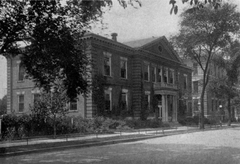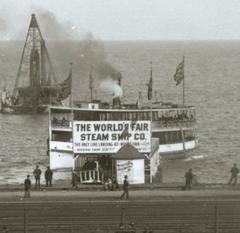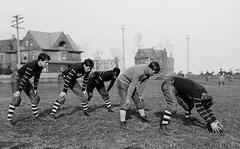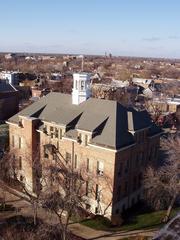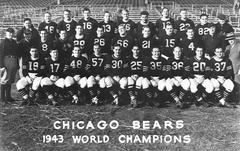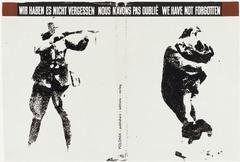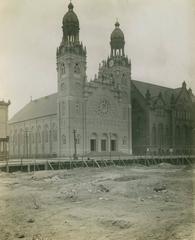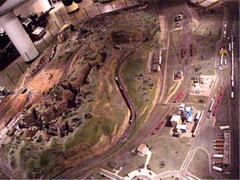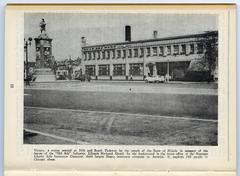सेकेंड लेटर बिल्डिंग: आगंतुक घंटे, टिकट और शिकागो ऐतिहासिक स्थल गाइड
दिनांक: 04/07/2025
परिचय
शिकागो की वास्तुकला और व्यावसायिक इतिहास में सेकेंड लेटर बिल्डिंग एक महत्वपूर्ण स्थल है। लूप के केंद्र में 401 एस स्टेट सेंट पर स्थित, 1891 की यह आठ-मंजिला संरचना, जिसे “गगनचुंबी इमारत का पिता” कहे जाने वाले विलियम ले बैरन जेनी ने डिजाइन किया था, अपने स्टील-फ्रेम निर्माण और अग्निरोधक डिजाइन के शुरुआती उपयोग के लिए प्रसिद्ध है। इन नवाचारों ने न केवल भवन निर्माण विधियों को बदल दिया, बल्कि सिएगल, कूपर एंड कंपनी और सीयर्स, रोबक एंड कंपनी जैसी प्रतिष्ठित किरायेदारों को आकर्षित करने वाले विशाल, लचीले खुदरा स्थानों को भी सक्षम बनाया (शिकागोोलॉजी, डेपॉल यूनिवर्सिटी शिकागो हिस्ट्री टाइमलाइन)।
आज, सेकेंड लेटर बिल्डिंग शिकागो स्कूल ऑफ आर्किटेक्चर का एक हॉलमार्क है, जिसमें इसकी लयबद्ध गुलाबी ग्रेनाइट की बाहरी दीवार और चौड़ी खिड़की की खाड़ी हैं। हालांकि यह मुख्य रूप से अब कार्यालय और शैक्षिक स्थान के रूप में कार्य करता है, फिर भी इमारत का संरक्षित बाहरी हिस्सा वास्तुकला के शौकीनों और आगंतुकों के लिए एक आकर्षक दृश्य बना हुआ है। यह गाइड व्यापक ऐतिहासिक संदर्भ, व्यावहारिक आगंतुक जानकारी, पहुंच विवरण और आस-पास के आकर्षणों को देखने की सिफारिशें प्रदान करता है—यह सब शिकागो के ऐतिहासिक शहरी परिदृश्य में रुचि रखने वाले किसी भी व्यक्ति के लिए एक पुरस्कृत अनुभव सुनिश्चित करता है।
विषय सूची
- परिचय
- ऐतिहासिक पृष्ठभूमि
- वास्तुशिल्प विशेषताएं और नवाचार
- आगंतुक जानकारी
- आस-पास के आकर्षण
- यात्रा और सुरक्षा युक्तियाँ
- अक्सर पूछे जाने वाले प्रश्न (FAQ)
- निष्कर्ष और कॉल टू एक्शन
- संदर्भ
ऐतिहासिक पृष्ठभूमि
निर्माण और वास्तुशिल्प दृष्टि
लेवी जेड. लेटर द्वारा कमीशन और विलियम ले बैरन जेनी द्वारा डिजाइन की गई, सेकेंड लेटर बिल्डिंग 1891 में पूरी हुई थी। जेनी के स्टील-फ्रेम कंकाल का अग्रणी उपयोग संरचना को आठ मंजिला तक बढ़ने की अनुमति देता है, जिसमें गहरी फर्श की प्लेटें और न्यूनतम आंतरिक कॉलम होते हैं। इसने बड़े खुदरा संचालन के लिए खुली जगह और लचीलेपन को अधिकतम किया, जबकि अग्निरोधक डिजाइन ने ग्रेट शिकागो फायर के बाद की चिंताओं को दूर किया (शिकागोोलॉजी)।
खुदरा विरासत: सिएगल, कूपर एंड कंपनी और सीयर्स
इसके पूरा होने के तुरंत बाद, इमारत सिएगल, कूपर एंड कंपनी का घर बन गई, जो उस युग के सबसे प्रमुख डिपार्टमेंट स्टोरों में से एक था। इसका मजबूत स्टील फ्रेम और खुला इंटीरियर इसे बड़ी खुदरा भीड़ और विस्तृत प्रदर्शनों को समायोजित करने के लिए आदर्श बनाता था। 1932 में, सीयर्स, रोबक एंड कंपनी—तब दुनिया का सबसे बड़ा खुदरा विक्रेता—ने इमारत को पट्टे पर लिया और उसका आधुनिकीकरण किया, जिसमें नवीनीकरण में लगभग $900,000 का निवेश किया गया। सीयर्स स्टेट स्ट्रीट स्टोर एक डाउनटाउन खुदरा एंकर बन गया, जिसने अपने उद्घाटन के दिन 150,000 से अधिक आगंतुकों को आकर्षित किया (शिकागोोलॉजी)।
विकास और अनुकूली पुन: उपयोग
20वीं सदी के उत्तरार्ध में उपभोक्ता की आदतों में बदलाव के साथ, डाउनटाउन डिपार्टमेंट स्टोर में गिरावट आई। सीयर्स ने 1983 में अपना स्टेट स्ट्रीट फ्लैगशिप बंद कर दिया, और सेकेंड लेटर बिल्डिंग को बाद में कार्यालय और शैक्षिक उपयोग के लिए पुन: तैयार किया गया, जो अनुकूली पुन: उपयोग और ऐतिहासिक संरक्षण के शहर की प्रतिबद्धता का एक उदाहरण है (शिकागोोलॉजी)।
वास्तुशिल्प विशेषताएं और नवाचार
- स्टील-फ्रेम निर्माण: जेनी की अभिनव कंकाल संरचना ने उच्च ऊंचाई और बड़े, खुले इंटीरियर की अनुमति दी - भविष्य के गगनचुंबी इमारतों के लिए एक मिसाल कायम की।
- बाहरी: लयबद्ध गुलाबी ग्रेनाइट, चौड़ी खिड़की की खाड़ी, और न्यूनतम अलंकरण शिकागो स्कूल के कार्यात्मक आदर्शों को दर्शाते हैं।
- अग्निरोधक: उन्नत अग्निरोधक सामग्री और डिजाइन ने ग्रेट शिकागो फायर के बाद उत्पन्न हुई सुरक्षा चिंताओं को दूर किया।
- लैंडमार्क स्थिति: इमारत को 1976 में राष्ट्रीय ऐतिहासिक लैंडमार्क और 1997 में शिकागो लैंडमार्क नामित किया गया था।
- आंतरिक विशेषताएं: हालांकि जनता के लिए खुला नहीं है, कास्ट-आयरन सीढ़ी जैसी ऐतिहासिक तत्व अंदर संरक्षित हैं (शिकागोोलॉजी)।
आगंतुक जानकारी
स्थान और पहुंच
- पता: 401 S State St, Chicago, IL 60605 (Evendo)
- सार्वजनिक परिवहन: सीटीए रेड और ब्लू लाइन सबवे स्टेशनों, विभिन्न बस मार्गों द्वारा आसानी से पहुँचा जा सकता है, और यात्रियों के रेल के लिए यूनियन स्टेशन के पास है।
- पार्किंग: पास में कई पार्किंग गैरेज हैं, हालांकि भारी यातायात और सीमित पार्किंग के कारण सार्वजनिक परिवहन की सिफारिश की जाती है।
- बाइक और पैदल चलना: यह क्षेत्र पैदल चलने वालों और बाइक के अनुकूल है, जिसमें गाइडेड बाइक टूर उपलब्ध हैं (शिकागो बाइक एडवेंचर्स)।
आगंतुक घंटे
- बाहरी दृश्य: इमारत के बाहरी हिस्से को किसी भी समय दिन के उजाले में देखा जा सकता है। कोई आधिकारिक आगंतुक घंटे नहीं हैं।
- आंतरिक पहुंच: इमारत वर्तमान में कार्यालय और शैक्षिक स्थान के रूप में कार्य करती है और आम तौर पर सार्वजनिक पर्यटन के लिए खुली नहीं है।
टिकट और प्रवेश
- बाहरी दृश्य: किसी भी टिकट या शुल्क की आवश्यकता नहीं है।
- विशेष टूर: सेकेंड लेटर बिल्डिंग को शामिल करने वाले गाइडेड वास्तुशिल्प टूर के लिए स्थानीय टूर प्रदाताओं के माध्यम से अग्रिम बुकिंग और शुल्क की आवश्यकता हो सकती है।
गाइडेड टूर और आगंतुक युक्तियाँ
- गाइडेड टूर: लूप के वॉकिंग और बाइक टूर अक्सर सेकेंड लेटर बिल्डिंग को एक मुख्य आकर्षण के रूप में शामिल करते हैं (शिकागो बाइक एडवेंचर्स)।
- स्व-निर्देशित यात्राएं: अपनी गति से अन्वेषण करने के लिए स्व-निर्देशित मानचित्रों और यात्रा ऐप्स का उपयोग करें (Evendo)।
- पहुंच: फुटपाथ चौड़े और व्हीलचेयर-अनुकूल हैं; हेरोल्ड वाशिंगटन लाइब्रेरी जैसी आस-पास की जगहों पर सार्वजनिक शौचालय उपलब्ध हैं।
आस-पास के आकर्षण
- हेरोल्ड वाशिंगटन लाइब्रेरी सेंटर: सड़क के ठीक पार, यह पोस्टमॉडर्न लैंडमार्क प्रदर्शनियों और पढ़ने के कमरे प्रदान करता है।
- शिकागो का आर्ट इंस्टीट्यूट: पूर्व में थोड़ी पैदल दूरी पर, प्रसिद्ध कला संग्रहों का घर।
- मिलेनियम पार्क: क्लाउड गेट मूर्तिकला, उद्यान और आउटडोर संगीत समारोह की सुविधाएँ।
- शिकागो बोर्ड ऑफ ट्रेड बिल्डिंग, द रूकरी, ग्रांट पार्क: पैदल दूरी के भीतर अन्य वास्तुशिल्प हाइलाइट्स।
यात्रा और सुरक्षा युक्तियाँ
- सुरक्षित रहने और इष्टतम फोटोग्राफी के लिए दिन के उजाले में यात्रा करें (CityPASS)।
- एक व्यापक अनुभव के लिए अपनी यात्रा को अन्य लूप लैंडमार्क के साथ मिलाएं।
- परतों में कपड़े पहनें और बाहरी टूर में भाग लेने पर वर्षा गियर लाएं (शिकागो बाइक एडवेंचर्स)।
- कुशल सार्वजनिक परिवहन के लिए वेंट्रा कार्ड और नेविगेशन ऐप का उपयोग करें (CityPASS)।
- व्यक्तिगत सामानों के प्रति सचेत रहें और अंधेरे के बाद अच्छी तरह से रोशनी वाली सड़कों का उपयोग करें (टाइमलेस ट्रैवल स्टेप्स)।
अक्सर पूछे जाने वाले प्रश्न (FAQ)
क्या मैं सेकेंड लेटर बिल्डिंग में प्रवेश कर सकता हूँ? नहीं, सार्वजनिक पहुंच बाहरी हिस्से तक ही सीमित है।
आगंतुक घंटे क्या हैं? इमारत को दिन के उजाले में किसी भी समय बाहर से देखा जा सकता है।
क्या टिकट आवश्यक हैं? जब तक आप किसी विशेष गाइडेड टूर में शामिल नहीं हो रहे हों, तब तक नहीं।
क्या साइट व्हीलचेयर सुलभ है? हाँ, फुटपाथ व्हीलचेयर और घुमक्कड़ के लिए उपयुक्त हैं।
क्या गाइडेड टूर उपलब्ध हैं? हाँ, स्थानीय वास्तुकला और बाइक टूर प्रदाताओं के माध्यम से।
क्या पास में पार्किंग है? हाँ, लेकिन भीड़भाड़ के कारण सार्वजनिक परिवहन की सिफारिश की जाती है।
निष्कर्ष और कॉल टू एक्शन
सेकेंड लेटर बिल्डिंग शिकागो की वास्तुशिल्प विरासत और वाणिज्यिक इतिहास का एक आधारशिला है, जो गगनचुंबी इमारत डिजाइन और शहरी वाणिज्य में नवाचार का प्रतीक है। हालांकि आंतरिक पहुंच सीमित है, इसका आकर्षक बाहरी हिस्सा और केंद्रीय लूप स्थान इसे वास्तुकला के प्रशंसकों और शहर के अन्वेषकों के लिए एक आवश्यक पड़ाव बनाता है। अपनी यात्रा को बेहतर बनाने के लिए एक गाइडेड टूर में शामिल हों, आस-पास के आकर्षणों का पता लगाएं, और अप-टू-डेट आगंतुक जानकारी और विशेष सामग्री के लिए ऑडिएला जैसे संसाधनों का उपयोग करें। नवीनतम शिकागो यात्रा अंतर्दृष्टि के लिए सोशल मीडिया पर हमसे जुड़े रहें।
संदर्भ
- शिकागोोलॉजी: शिकागो वास्तुकला का स्वर्ण युग
- डेपॉल यूनिवर्सिटी शिकागो हिस्ट्री टाइमलाइन
- Evendo - सेकेंड लेटर बिल्डिंग
- शिकागो बाइक एडवेंचर्स
- CityPASS शिकागो टिप्स
- टाइमलेस ट्रैवल स्टेप्स शिकागो सुरक्षा
- शिकागो डिज़ाइनस्लिंगर
- सीक्रेट शिकागो
ऑडिएला2024’, ‘headers’: {‘date’: ‘Date’, ‘title’: ‘Second Leiter Building Visiting Hours Tickets and Chicago Historical Sites Guide’, ‘conclusion’: ‘Summary of key points about visiting the Second Leiter Building and related Chicago historical sites’, ‘references’: ‘References including official websites and credible sources for more information’, ‘introduction’: ‘Introduction to the Second Leiter Building and its significance in Chicago’, ‘table_of_contents’: ‘Table of Contents including visiting hours tickets history cultural significance travel tips nearby attractions and accessibility’}, ‘sources’: [’- Chicagology: The Golden Age of Chicago Architecture, 2023, Unknown Author https://chicagology.com/goldenage/goldenage030/’, ’- DePaul University Chicago History Timeline, 2012, DePaul University https://teacher.depaul.edu/Documents/Chicago%20History%20Timeline%201800-2008%20updated%204-12-12.pdf’, ’- Evendo - Second Leiter Building, 2024, Evendo https://evendo.com/locations/illinois/northeastern-illinois/landmark/second-leiter-building’, ’- Chicago Bike Adventures, 2024, Chicago Bike Adventures https://chicagobikeadventures.com/secondleiterbuilding/’], ‘sections’: [‘Historical Background’, ‘Architectural Significance’, ‘Visitor Experience’, ‘Cultural and Urban Context’], ‘conclusion’: ‘The Second Leiter Building remains a cornerstone of Chicago’s architectural heritage and commercial history, symbolizing the city’s emergence as a leader in skyscraper innovation and retail development. Its groundbreaking steel-frame construction, fireproof design, and adaptable interior spaces not only transformed the urban landscape of Chicago but also set standards that influenced architectural practices throughout the United States. Although interior access is limited due to the building’s current use as office and educational space, the well-preserved exterior continues to attract architecture enthusiasts, historians, and visitors eager to witness this emblem of the Chicago School firsthand.\n\nSituated in the heart of Chicago’s Loop, the building’s proximity to other iconic landmarks and cultural institutions makes it an integral part of a broader exploration of the city’s rich history and vibrant urban life. Whether experienced through self-guided walks, organized architectural tours, or engaging bike routes, the Second Leiter Building offers a compelling narrative of innovation, commerce, and preservation. Visitors are encouraged to take advantage of available resources such as the Audiala app for up-to-date tour information, and to explore related Chicago architectural attractions to fully appreciate the legacy encapsulated by this historic site (Chicagology, Chicago Bike Adventures, Evendo).\n\nBy visiting the Second Leiter Building and its surrounding district, travelers connect with a vital chapter in Chicago’s evolution—a story of resilience, innovation, and enduring architectural excellence that continues to inspire and educate future generations.’, ‘introduction’: ‘The Second Leiter Building stands as a pivotal landmark in Chicago’s architectural and commercial history, embodying the city’s pioneering spirit in skyscraper innovation and retail evolution. Erected in 1891 at the bustling intersection of State and Van Buren Streets, this eight-story structure designed by William Le Baron Jenney—often hailed as the “father of the skyscraper”—is celebrated for its early adoption of steel-frame construction and fireproof design. These features not only revolutionized building techniques but also facilitated expansive, flexible retail spaces that accommodated some of Chicago’s most prominent department stores, including Siegel, Cooper & Co. and later Sears, Roebuck & Co. (Chicagology, DePaul University Chicago History Timeline).\n\nToday, the Second Leiter Building remains an iconic testament to the Chicago School of architecture, with its rhythmic pink granite façade, large window bays, and open interior floor plans that influenced modern commercial architecture nationwide. While the building is primarily used as office and educational space and is not generally open for interior public tours, its exterior can be admired at any time during daylight hours. Visitors can deepen their appreciation through guided walking or bike tours offered by local architectural organizations and explore nearby landmarks such as the Chicago Board of Trade Building, the Harold Washington Library Center, and Millennium Park, enriching the experience of Chicago’s vibrant Loop district (Chicago Bike Adventures, Evendo).\n\nThis comprehensive guide provides detailed historical context, architectural insights, practical visiting information including accessibility, travel tips, and highlights of nearby attractions to help visitors plan a rewarding and informed visit to this architectural gem in Chicago’s storied urban landscape.’, ‘research_data’: [{‘draft title’: ’# Second Leiter Building Chicago: Visiting Hours, Tickets, Historical Significance, and Visitor Guide\n\n## Introduction\n\nThe Second Leiter Building is a landmark of Chicago’s architectural innovation and retail history. Located at the intersection of State and Van Buren Streets, this historic steel-frame building is a must-see for visitors interested in Chicago’s evolution as a commercial and architectural powerhouse. In this article, we explore the building’s fascinating history, architectural features, and provide practical information for those planning a visit—including visiting hours, ticketing, accessibility, and nearby attractions.\n\n## Historical Background\n\n### Early Origins and Architectural Vision\n\nDesigned by William Le Baron Jenney, often called the “father of the skyscraper,” the Second Leiter Building was constructed in 1891. It exemplifies early steel-frame architecture, a pioneering method that allowed for taller buildings with open interior spaces. This innovation set the stage for future skyscraper construction not only in Chicago but across the United States (chicagology.com).\n\nCommissioned by Levi Z. Leiter, a prominent Chicago businessman, the building was designed with fireproofing and flexibility in mind—an important consideration following the Great Chicago Fire of 1871 (teacher.depaul.edu). Its open floor plans and minimal interior columns allowed retailers to customize spaces to their needs.\n\n### Commercial Tenancy and Early Retail Giants\n\nSoon after completion, the building became home to Siegel, Cooper & Co., a major department store in the 1890s. Its robust steel frame and open interiors were perfect for large-scale retail operations, supporting flexible merchandising and accommodating high customer volume on State Street, Chicago’s premier shopping corridor of the time (chicagology.com).\n\n### Transition to Sears, Roebuck & Co.\n\nIn the early 1930s, Sears, Roebuck & Co., then the world’s largest retailer, leased the building for 20 years. Sears invested approximately $900,000 to remodel and modernize the eight-story structure, adding new show windows, model rooms, and state-of-the-art amenities like electric wiring and sprinkler systems. The grand opening on May 3, 1932, drew more than 151,300 visitors, marking the store as a downtown anchor of retail dominance (chicagology.com).\n\n## Architectural Features and Innovations\n\nThe Second Leiter Building’s steel-frame construction allowed for unprecedented flexibility in design and use. Its façade features a rhythmic grid of windows with understated ornamentation characteristic of the Chicago School of architecture. The 1932 renovation introduced model rooms that showcased furniture in realistic settings, a novel retail concept at the time (chicagology.com). Modern fireproofing measures were also implemented, enhancing safety.\n\n## Role in Chicago’s Retail Landscape\n\nThroughout the 20th century, the building was central to State Street’s reputation as Chicago’s main shopping destination. Alongside other iconic department stores like Marshall Field’s and Carson Pirie Scott, it drew millions of shoppers and contributed to the economic vitality of the Loop (teacher.depaul.edu).\n\nIts adaptability allowed it to evolve with changing retail trends, maintaining commercial appeal even as the industry shifted.\n\n## Decline of the Department Store Era and Adaptive Reuse\n\nBy the late 20th century, suburban malls and changing consumer habits led to the closure of many downtown department stores. Sears closed its flagship State Street store in 1983, ending a major chapter in the building’s retail history (chicagology.com). Subsequently, the building was remodeled into office space, exemplifying urban redevelopment and adaptive reuse.\n\n## Preservation and Legacy\n\nToday, the Second Leiter Building stands as a preserved architectural and historical landmark. Its steel-frame design, retail legacy, and association with major Chicago businesses have earned it a distinguished place in American architectural history. Preservation efforts ensure that its distinctive features remain for future generations (chicagology.com).\n\n## Visiting the Second Leiter Building\n\n### Visiting Hours\n\nAs the building currently functions primarily as office space, public access is limited. However, the exterior can be viewed at any time from the sidewalks of State and Van Buren Streets. Special guided tours may occasionally be offered by Chicago architecture organizations; visitors should check with local tour providers for availability.\n\n### Tickets and Admission\n\nThere is no general admission fee to view the building’s exterior. For any special events or tours, ticketing details will be provided by the event organizers.\n\n### Accessibility\n\nThe surrounding area, including sidewalks and nearby public transit, is accessible. For interior access or special events, visitors should inquire about specific accessibility accommodations.\n\n### Guided Tours and Visitor Tips\n\nVisitors interested in the Second Leiter Building can include it in Chicago architectural tours that cover the Loop and State Street. Combining a visit with nearby sites such as the Chicago Board of Trade Building and the Rookery Building enriches the experience.\n\n### Nearby Attractions\n\n- Chicago Board of Trade Building – Another architectural icon just a short walk away.\n- Marshfield Building – Historic department store architecture nearby.\n- Chicago Riverwalk – A scenic spot for walking and dining.\n\n## Visuals and Media\n\nFor visitors and researchers, high-quality images and virtual tours of the Second Leiter Building are available through Chicago architecture websites and local historical societies. Including keyword-rich alt tags like “Second Leiter Building Chicago steel-frame architecture” helps with online searches.\n\n## Frequently Asked Questions (FAQ)\n\nQ: Can I visit the interior of the Second Leiter Building? \nA: The building primarily serves as office space, so interior access is limited. Check for special tours or events.\n\nQ: What are the building’s visiting hours? \nA: The exterior can be viewed anytime from public streets. Interior access depends on events.\n\nQ: Is there an admission fee? \nA: No fee to view the exterior; special events may require tickets.\n\nQ: Is the building wheelchair accessible? \nA: Public sidewalks and nearby transit are accessible. Contact event organizers for interior accessibility.\n\nQ: What public transportation serves the area? \nA: The building is accessible via multiple CTA bus lines and the State Street subway station.\n\n## Call to Action\n\nPlan your visit to the Second Leiter Building and discover Chicago’s rich architectural heritage. For the latest updates on tours and events, download the Audiala app, follow our social media channels, and explore related articles on Chicago’s historic buildings.\n\n---\n\nReferences:\n- Chicagology: The Golden Age of Chicago Architecture\n- DePaul University Chicago History Timeline’}, {‘Exploring the Second Leiter Building: Visiting Hours, Tickets, and Architectural Significance in Chicago’: ”## Exploring the Second Leiter Building: Visiting Hours, Tickets, and Architectural Significance in Chicago\n\n### Introduction\n\nLocated in the heart of Chicago’s historic State Street district, the Second Leiter Building is a must-see destination for visitors interested in architectural innovation and the city’s rich commercial heritage. This article provides an engaging overview of the building’s architectural significance alongside essential visitor information, including visiting hours, ticketing, accessibility, and nearby attractions.\n\n### Visiting the Second Leiter Building\n\n#### Visiting Hours and Tickets\nThe Second Leiter Building is primarily used as office and educational space today and is not generally open for public tours. However, visitors interested in viewing the exterior and appreciating its architectural features can visit the building’s prominent location at the northeast corner of South State Street and East Ida B. Wells Drive any time during daylight hours. There is no entrance fee for viewing the building from the outside.\n\nFor special events or guided tours, which are occasionally offered by local historical societies and architectural organizations, check their websites or contact the Chicago Architecture Foundation for updated schedules.\n\n#### Accessibility\nThe building’s exterior is fully accessible via sidewalks and public transportation. While interior access may be limited due to its current usage, nearby public spaces and landmarks offer accessible amenities.\n\n### Architectural Significance of the Second Leiter Building\n\n#### Pioneering Skeletal-Frame Construction\nDesigned by William Le Baron Jenney and completed in 1891, the Second Leiter Building is a landmark in modern architecture for its innovative skeletal-frame construction. Often called the “father of the skyscraper,” Jenney’s use of a metal skeleton frame allowed for greater building height, larger open floor plates, and flexible interior layouts, setting a precedent for Chicago’s iconic skyline.\n\nThough not the first fully iron-framed building in Chicago—due to its loadbearing brick rear wall—the structural system was revolutionary and influenced skyscraper development nationwide.\n\n#### Design Features and Materials\nThe eight-story building spans an entire city block and features a distinctive pink granite façade. The State Street side is organized into nine bays with wide pilasters and a simple cornice, reflecting a restrained, functional aesthetic. Interiors originally boasted deep floor plates of 144 feet and 16-foot ceilings supported by slender iron columns, creating open, light-filled spaces ideal for retail and commercial use.\n\n#### Fireproofing and Structural Innovation\nFollowing the Great Chicago Fire of 1871, fire resistance became paramount. Jenney’s steel frame combined with fireproof materials made the building safer than timber-framed predecessors, influencing building codes and practices. Large windows allowed ample natural light, enhancing its retail environment.\n\n#### Influence on the Chicago School and Modern Architecture\nThe building exemplifies the Chicago School’s functional design and structural honesty, influencing architects like Louis Sullivan and Daniel Burnham. It foreshadowed the International Style and future glass-and-steel skyscrapers.\n\n#### Adaptability and Longevity\nOriginally a department store for Siegel, Cooper and later Sears, Roebuck’s flagship, the building’s large open floors facilitated adaptation to new uses, including office and classroom space for Robert Morris University. A preserved cast-iron staircase remains a historic interior feature.\n\n#### Landmark Status and Recognition\nDesignated a National Historic Landmark in 1976 and a Chicago Landmark in 1997, the building is recognized for its architectural and historical importance.\n\n#### Comparative Context and Legacy\nConceived in competition with Marshall Field’s Wholesale Store, the Second Leiter Building’s larger size and modern design symbolized Chicago’s architectural ambition. It remains a key reference for architecture students and visitors.\n\n### Nearby Attractions and Travel Tips\n\nWhile in the area, visitors can explore other Chicago landmarks such as the Chicago Theatre, Harold Washington Library, and the historic Chicago Riverwalk. State Street itself offers shopping, dining, and cultural experiences.\n\nPublic transportation options include the CTA Red Line and numerous bus routes, making access easy. Comfortable walking shoes are recommended to fully appreciate the neighborhood’s architectural gems.\n\n### Visuals and Media\nVisitors and readers can find high-quality images and virtual tours on the Chicago Architecture Foundation website and the SAH Archipedia online portal. These resources provide detailed views of the building’s exterior and historical context.\n\n### FAQ\n\nQ: What are the visiting hours for the Second Leiter Building? \nA: The building is not open for general public tours, but the exterior can be viewed any time during daylight hours.\n\nQ: Is there an entrance fee? \nA: No, viewing the building’s exterior is free.\n\nQ: Is the building accessible for people with disabilities? \nA: Exterior areas are accessible; interior access may be limited due to current use.\n\nQ: Are guided tours available? \nA: Occasionally, through local historical organizations—check their websites for schedules.\n\nQ: What other Chicago landmarks are nearby? \nA: Chicago Theatre, Harold Washington Library, Chicago Riverwalk, and more.\n\n### Conclusion and Call to Action\n\nThe Second Leiter Building stands as a testament to Chicago’s pioneering spirit in architecture and urban development. Whether you’re an architecture enthusiast or a curious traveler, exploring this historic site and its surroundings offers valuable insight into the city’s evolution.\n\nPlan your visit today, explore related Chicago landmarks on our site, and download the Audiala app for guided tours and up-to-date event information. Follow us on social media to stay connected with the latest news and travel tips.\n\n---\n\n### Key Architectural Data\n\n- Architect: William Le Baron Jenney \n- Year Completed: 1891 \n- Height: 8 stories \n- Floor Area: Approx. 553,000 sq ft \n- Floor Plate Depth: 144 ft \n- Ceiling Height: 16 ft per floor \n- Façade Material: Pink granite \n- Structural System: Steel skeleton frame with some loadbearing brick at the rear \n- Landmark Status: National Historic Landmark (1976), Chicago Landmark (1997) \n- Notable Features: Nine-bay State Street façade, large open floor plates, cast-iron staircase\n\n---\n\nFor more on Chicago’s architectural gems, visit our related posts on the Chicago School, the Great Chicago Fire, and iconic skyscrapers.’}, {‘Visiting the Second Leiter Building in Chicago: Hours, Tickets, and Nearby Historical Sites’: ’## Introduction\n\nDiscover the architectural marvel of the Second Leiter Building, a cornerstone of Chicago’s rich historical and commercial legacy. Located in the vibrant Loop district, this landmark offers visitors a unique glimpse into the origins of the modern skyscraper. This guide will cover essential visitor information, including visiting hours, ticketing details, accessibility, and nearby historical sites, ensuring you have a memorable experience exploring this iconic Chicago historical site.\n\n## Location and Accessibility\n\nThe Second Leiter Building is situated at 401 S State St, Chicago, IL 60605, at the heart of the Loop, one of Chicago’s most dynamic and historically significant neighborhoods (Evendo). Its central location makes it easily accessible via multiple transportation options:\n\n- By Car: From Northeastern Illinois, take I-90/I-94 South toward Chicago, exit at 18th St, and follow signs for the Dan Ryan Expressway. Exit 51A leads to State St. Parking garages nearby typically charge $10–$30 for a few hours (Evendo).\n- By Train: Take a Metra train to Union Station, then transfer to the CTA ‘L’ Green or Pink Line to Harold Washington Library Station. The building is a 10-minute walk east on W Congress Pkwy, then south on S State St (Evendo).\n- By Bus: CTA bus routes serving the Loop stop conveniently at State & Adams. Walk south on S State St to reach the building (Evendo).\n- On Foot or Bike: The Loop is pedestrian and bike-friendly. Guided bike tours, such as those by Chicago Bike Adventures, offer an engaging way to explore the area and its architecture (Chicago Bike Adventures).\n\n## Visiting Hours and Ticket Information\n\n- Visiting Hours: The Second Leiter Building is accessible only from the outside. There are no official visiting hours, as the exterior can be viewed any time during daylight hours. For the best experience and safety, visiting during daylight is recommended.\n- Tickets: There is no entry fee or tickets required since the building is not open to the public. Visitors can freely admire the building’s façade and architectural details from the surrounding streets.\n\n## Exterior Viewing and Architectural Highlights\n\nAlthough the interior of the Second Leiter Building is closed to the public, its exterior is a remarkable attraction for architecture lovers and photographers alike. Designed by William Le Baron Jenney in 1891, the building is a pioneering example of the Chicago School and early skyscraper design (Evendo).\n\n- Architectural Features: Notable for its steel-frame construction, large windows, symmetry, and minimal ornamentation, the building embodies the functionalist ideals of its era.\n- Photographic Opportunities: Capture stunning images from across State Street or the corners of State and Congress Parkway. Early mornings and late afternoons provide optimal lighting (CityPASS).\n\n \n\nAlt text: The exterior façade of the Second Leiter Building showcasing large windows and steel-frame construction.\n\n## Visitor Experience and On-Site Atmosphere\n\n### Street-Level Engagement\n\nStroll around the building to appreciate its scale and craftsmanship, set against the bustling energy of the Loop. Nearby attractions such as the Harold Washington Library, the Art Institute of Chicago, and Millennium Park are easily accessible on foot (Evendo).\n\n### Guided and Self-Guided Tours\n\n- Bike Tours: Chicago Bike Adventures offers custom guided bike tours featuring the Second Leiter Building as a highlight, with knowledgeable guides tailoring routes to interests and fitness levels (Chicago Bike Adventures).\n- Walking Tours: Architectural walking tours of the Loop often include the building as a key stop, providing rich historical context.\n- Self-Guided Exploration: Use self-guided maps and apps like Evendo’s travel guide to explore at your own pace (Evendo).\n\n## Accessibility and Amenities\n\n- Accessibility: Sidewalks around the building are wide and wheelchair-friendly, suitable for strollers.\n- Facilities: As the building is closed to the public, visitors should use restrooms at nearby venues such as the Harold Washington Library or local cafes.\n- Dining: The Loop offers a diverse range of dining options within walking distance, from casual eateries to upscale restaurants.\n\n## Tips for a Memorable Visit\n\n- Visit early in the morning or late afternoon to avoid crowds and enjoy optimal lighting for photography (CityPASS).\n- Combine your visit with other Loop landmarks like the Chicago Board of Trade, the Rookery Building, and Grant Park.\n- Dress in layers and bring rain gear, especially if participating in outdoor tours (Chicago Bike Adventures).\n- Stay aware of your surroundings and keep valuables secure. Use well-lit, populated streets after dark (Timeless Travel Steps).\n- Purchase a Ventra Card for easy access to public transit. Apps like CityMapper can help navigate routes efficiently (CityPASS).\n\n## Cultural and Historical Context\n\nThe Second Leiter Building is a symbol of Chicago’s entrepreneurial spirit and architectural innovation. Originally a bustling retail hub, it played a key role in the city’s economic growth in the late 19th and early 20th centuries (Evendo). It remains a tangible link to Chicago’s storied past, embodying the evolution of commercial architecture worldwide.\n\n## Nearby Attractions and Experiences\n\n- Harold Washington Library Center: Steps away, this postmodern landmark offers exhibitions, reading rooms, and city views.\n- Art Institute of Chicago: A short walk east, featuring an extensive global art collection.\n- Millennium Park: Home to the iconic Cloud Gate sculpture, gardens, and outdoor concerts.\n- Dining and Shopping: The Loop provides diverse restaurants, cafes, and retail stores for an extended visit.\n\n## Frequently Asked Questions (FAQ)\n\nCan I enter the Second Leiter Building?\nNo, the building’s interior is not open to the public. Visitors can only view the exterior.\n\nWhat are the visiting hours?\nThere are no official visiting hours since the building is accessible from the outside at any time. It is recommended to visit during daylight for safety and better viewing.\n\nAre tickets required?\nNo tickets or fees are needed to view the building’s exterior.\n\nAre there guided tours available?\nWhile there are no official interior tours, various bike and walking tours in the Loop include the Second Leiter Building as a highlight.\n\nIs the site wheelchair accessible?\nYes, sidewalks around the building are wheelchair and stroller friendly.\n\nAre there any special events?\nThe building itself does not host events, but the surrounding Loop district frequently hosts cultural and architectural events worth exploring.\n\n## Practical Information\n\n- Entry Fee: Free to view from outside.\n- Photography: Handheld cameras and smartphones are welcome; tripods may be restricted on busy sidewalks.\n- Tour Bookings: Consider joining Loop architecture tours or custom bike tours for an enriched experience (Chicago Bike Adventures).\n\n## Visitor Feedback\n\nVisitors appreciate seeing Chicago through local guides’ perspectives, the building’s historical significance, and the ease of combining this stop with other Loop attractions. Active tours such as biking provide a fresh way to experience Chicago’s neighborhoods and history (Chicago Bike Adventures).\n\n## Local Insights\n\nEngage with small group tours for personalized insights into Chicago’s culture and history. If time allows, explore adjacent neighborhoods to experience the city’s diverse vibrancy.\n\n## Conclusion\n\nThe Second Leiter Building stands as a testament to Chicago’s pioneering architectural spirit and urban development. While interior access is not available, its exterior offers a compelling visit, especially when combined with nearby historical sites. For a deeper dive into Chicago’s architectural heritage, consider guided tours and explore the Loop district’s rich offerings.\n\nFor more travel tips, architectural insights, and Chicago exploration guides, download the Audiala app and follow us on social media. Stay updated with the latest tours, events, and exclusive content to make your Chicago visit unforgettable.\n\n---\n\nInternal Links:\n- Explore our Guide to Chicago Architecture\n- Discover Top Chicago Historical Sites\n- Plan your visit with our Chicago Loop Walking Tour\n\nExternal Resources:\n- Evendo - Second Leiter Building\n- Chicago Bike Adventures\n- CityPASS Chicago Tips\n- Timeless Travel Steps Chicago Safety\n’}, {‘Visiting the Second Leiter Building in Chicago: History, Hours & Nearby Attractions’: ’## Introduction\n\nDiscover the architectural marvel of the Second Leiter Building, a cornerstone of Chicago’s rich historical and commercial legacy. Located in the vibrant Loop district, this landmark offers visitors a unique glimpse into the origins of the modern skyscraper. This guide will cover essential visitor information, including visiting hours, ticketing details, accessibility, and nearby historical sites, ensuring you have a memorable experience exploring this iconic Chicago historical site.\n\n## Urban Setting and Neighborhood Character\n\nThe Second Leiter Building sits at 403 South State Street, a key address in Chicago’s bustling Loop. This central business district is packed with historic architecture, shops, cultural institutions, and vibrant street life. State Street, once famed as “that great street,” has been the city’s retail and entertainment hub for over a century. The building’s location places it among other landmarks like the Harold Washington Library Center and the Palmer House Hilton, creating a rich urban tapestry that draws both locals and visitors (Chicago Designslinger).\n\n## Architectural Influence on the Urban Landscape\n\nDesigned in 1891 by William Le Baron Jenney, the Second Leiter Building is a pioneering example of the Chicago School of architecture. Its innovative steel-frame construction, large plate-glass windows, and minimal ornamentation set the stage for modern commercial buildings. This eight-story structure’s long façade reflects the shift from heavy masonry to skeletal steel frames that shaped Chicago’s skyline. Its focus on function and natural light introduced open floor plans and wide bays, influencing commercial architecture across the country.\n\n## Integration with Chicago’s Cultural Life\n\nSituated near world-class museums, theaters, and public art, the building benefits from Chicago’s rich cultural scene. Visitors can easily walk to the Art Institute of Chicago, the Chicago Symphony Center, and Millennium Park, which offers free summer concerts and art exhibitions (Secret Chicago). Since 1997, the building houses Robert Morris University (now part of Roosevelt University), blending historic preservation with educational use.\n\n## Accessibility and Transportation\n\nThe Second Leiter Building is highly accessible, thanks to the Loop’s extensive public transit network. The CTA Red and Blue Line subway stations are just a block away, with numerous bus routes on State Street. It’s also close to Union Station and Ogilvie Transportation Center for commuter rail access. Wide sidewalks and bike lanes, along with nearby Divvy bike-share stations, make pedestrian and bike access easy. While several parking garages serve the area, public transit is recommended due to heavy traffic and limited parking.\n\n## Visitor Information\n\nVisiting Hours: The building is open Monday through Friday, from 8:00 AM to 6:00 PM. Hours may vary during holidays and university breaks.\n\nTickets and Entry: The Second Leiter Building is primarily used for educational purposes and does not require tickets for general entry. However, public tours may be available through organizations like the Chicago Architecture Center—check their website for schedules and ticketing information.\n\nGuided Tours: Guided walking tours that include the Second Leiter Building are offered regularly by local architecture groups. These tours provide insights into the building’s history and architectural significance.\n\nPhotography: The building’s façade and interior offer excellent photo opportunities, especially during daylight hours when natural light highlights its design features.\n\nAccessibility: The building is wheelchair accessible, with ramps and elevators available to visitors.\n\n## Relationship to Chicago’s Retail and Commercial Heritage\n\nOriginally built for Levi Z. Leiter’s department store operations, the building played a key role in Chicago’s retail golden age. It housed Siegel, Cooper & Co., a major department store around 1900, designed to accommodate large crowds and flexible merchandising. Although State Street has evolved into a mixed-use corridor, the Second Leiter Building remains a strong link to the city’s commercial past, now serving educational and office tenants (Chicago Designslinger).\n\n## Public Art, Events, and Street Life\n\nThe Loop is famous for lively street events and public art. Near the Second Leiter Building, Millennium Park hosts the annual Grant Park Music Festival, free outdoor concerts, and art installations like Anish Kapoor’s “Cloud Gate” and Jaume Plensa’s “Crown Fountain” (Secret Chicago). State Street frequently features parades, festivals, and pop-up markets, with active ground-floor retail spaces that engage directly with pedestrians.\n\n## Nearby Attractions and Amenities\n\nVisitors can easily explore the Harold Washington Library Center, one of the largest public libraries globally, just across the street. The Art Institute of Chicago and the Chicago Cultural Center—with its famous Tiffany glass dome—are a short walk away (Secret Chicago). Dining options range from classic Chicago deep-dish pizza to international cuisine, and several historic hotels nearby, like the Palmer House Hilton, provide convenient accommodations.\n\n## Preservation and Community Engagement\n\nListed on the National Register of Historic Places, the Second Leiter Building has preserved its distinctive red brick and terra cotta façade, rhythmic window bays, and steel frame. Its role as an educational facility exemplifies Chicago’s dedication to integrating historic preservation with modern use. Public tours and educational programs offered by organizations like the Chicago Architecture Center help connect the community with the city’s architectural heritage.\n\n## Seasonal Context and Visitor Experience in July\n\nJuly is an ideal time to visit the Second Leiter Building and Chicago’s Loop. The city buzzes with summer festivals, free outdoor concerts at Millennium Park’s Jay Pritzker Pavilion, and weekly fireworks at Navy Pier (Secret Chicago). The Maxwell Street Market and vibrant street art add to the colorful urban experience. The area’s walkability and concentration of attractions make it easy to combine sightseeing with cultural activities.\n\n## Frequently Asked Questions (FAQ)\n\nQ: What are the Second Leiter Building visiting hours?\nA: The building is open Monday to Friday, 8:00 AM to 6:00 PM. Hours may vary during holidays.\n\nQ: Is there an admission fee or tickets required?\nA: There is no general admission fee as the building functions primarily as an educational facility. Public tours may require tickets through third-party providers.\n\nQ: Are guided tours available?\nA: Yes, guided walking tours including the building are offered by groups like the Chicago Architecture Center.\n\nQ: Is the building wheelchair accessible?\nA: Yes, the building offers ramps and elevators for accessibility.\n\nQ: What are the best times for photography?\nA: Daylight hours, especially morning or late afternoon, provide optimal natural light for photos.\n\n## Call to Action\n\nPlan your visit to the Second Leiter Building today and explore one of Chicago’s iconic historical sites! For more details, download the Audiala mobile app for up-to-date visitor information, interactive maps, and exclusive tours. Don’t forget to check out our related articles on Chicago’s architectural landmarks and follow us on social media for the latest updates and events.\n\n---\n\nImages and Media Suggestions: Include high-quality images of the building’s façade and interior with alt tags such as “Second Leiter Building Chicago historical site” and “Chicago architecture steel-frame building.” Embed an interactive map showing the building’s location within the Loop and links to virtual tours where available.\n\nInternal Links: Link to articles on Chicago’s Loop district, Millennium Park, and the Chicago Architecture Center.\n\nExternal Links: Ensure all external links point to official or authoritative sources like the Chicago Architecture Center, Roosevelt University, and Chicago Transit Authority.’}]## Inside the Second Leiter Building: A Look at its Historic Features
\n\nAlt text: The exterior façade of the Second Leiter Building showcasing large windows and steel-frame construction.\n\n## Visitor Experience and On-Site Atmosphere\n\n### Street-Level Engagement\n\nStroll around the building to appreciate its scale and craftsmanship, set against the bustling energy of the Loop. Nearby attractions such as the Harold Washington Library, the Art Institute of Chicago, and Millennium Park are easily accessible on foot (Evendo).\n\n### Guided and Self-Guided Tours\n\n- Bike Tours: Chicago Bike Adventures offers custom guided bike tours featuring the Second Leiter Building as a highlight, with knowledgeable guides tailoring routes to interests and fitness levels (Chicago Bike Adventures).\n- Walking Tours: Architectural walking tours of the Loop often include the building as a key stop, providing rich historical context.\n- Self-Guided Exploration: Use self-guided maps and apps like Evendo’s travel guide to explore at your own pace (Evendo).\n\n## Accessibility and Amenities\n\n- Accessibility: Sidewalks around the building are wide and wheelchair-friendly, suitable for strollers.\n- Facilities: As the building is closed to the public, visitors should use restrooms at nearby venues such as the Harold Washington Library or local cafes.\n- Dining: The Loop offers a diverse range of dining options within walking distance, from casual eateries to upscale restaurants.\n\n## Tips for a Memorable Visit\n\n- Visit early in the morning or late afternoon to avoid crowds and enjoy optimal lighting for photography (CityPASS).\n- Combine your visit with other Loop landmarks like the Chicago Board of Trade, the Rookery Building, and Grant Park.\n- Dress in layers and bring rain gear, especially if participating in outdoor tours (Chicago Bike Adventures).\n- Stay aware of your surroundings and keep valuables secure. Use well-lit, populated streets after dark (Timeless Travel Steps).\n- Purchase a Ventra Card for easy access to public transit. Apps like CityMapper can help navigate routes efficiently (CityPASS).\n\n## Cultural and Historical Context\n\nThe Second Leiter Building is a symbol of Chicago’s entrepreneurial spirit and architectural innovation. Originally a bustling retail hub, it played a key role in the city’s economic growth in the late 19th and early 20th centuries (Evendo). It remains a tangible link to Chicago’s storied past, embodying the evolution of commercial architecture worldwide.\n\n## Nearby Attractions and Experiences\n\n- Harold Washington Library Center: Steps away, this postmodern landmark offers exhibitions, reading rooms, and city views.\n- Art Institute of Chicago: A short walk east, featuring an extensive global art collection.\n- Millennium Park: Home to the iconic Cloud Gate sculpture, gardens, and outdoor concerts.\n- Dining and Shopping: The Loop provides diverse restaurants, cafes, and retail stores for an extended visit.\n\n## Frequently Asked Questions (FAQ)\n\nCan I enter the Second Leiter Building?\nNo, the building’s interior is not open to the public. Visitors can only view the exterior.\n\nWhat are the visiting hours?\nThere are no official visiting hours since the building is accessible from the outside at any time. It is recommended to visit during daylight for safety and better viewing.\n\nAre tickets required?\nNo tickets or fees are needed to view the building’s exterior.\n\nAre there guided tours available?\nWhile there are no official interior tours, various bike and walking tours in the Loop include the Second Leiter Building as a highlight.\n\nIs the site wheelchair accessible?\nYes, sidewalks around the building are wheelchair and stroller friendly.\n\nAre there any special events?\nThe building itself does not host events, but the surrounding Loop district frequently hosts cultural and architectural events worth exploring.\n\n## Practical Information\n\n- Entry Fee: Free to view from outside.\n- Photography: Handheld cameras and smartphones are welcome; tripods may be restricted on busy sidewalks.\n- Tour Bookings: Consider joining Loop architecture tours or custom bike tours for an enriched experience (Chicago Bike Adventures).\n\n## Visitor Feedback\n\nVisitors appreciate seeing Chicago through local guides’ perspectives, the building’s historical significance, and the ease of combining this stop with other Loop attractions. Active tours such as biking provide a fresh way to experience Chicago’s neighborhoods and history (Chicago Bike Adventures).\n\n## Local Insights\n\nEngage with small group tours for personalized insights into Chicago’s culture and history. If time allows, explore adjacent neighborhoods to experience the city’s diverse vibrancy.\n\n## Conclusion\n\nThe Second Leiter Building stands as a testament to Chicago’s pioneering architectural spirit and urban development. While interior access is not available, its exterior offers a compelling visit, especially when combined with nearby historical sites. For a deeper dive into Chicago’s architectural heritage, consider guided tours and explore the Loop district’s rich offerings.\n\nFor more travel tips, architectural insights, and Chicago exploration guides, download the Audiala app and follow us on social media. Stay updated with the latest tours, events, and exclusive content to make your Chicago visit unforgettable.\n\n---\n\nInternal Links:\n- Explore our Guide to Chicago Architecture\n- Discover Top Chicago Historical Sites\n- Plan your visit with our Chicago Loop Walking Tour\n\nExternal Resources:\n- Evendo - Second Leiter Building\n- Chicago Bike Adventures\n- CityPASS Chicago Tips\n- Timeless Travel Steps Chicago Safety\n’}, {‘Visiting the Second Leiter Building in Chicago: History, Hours & Nearby Attractions’: ’## Introduction\n\nDiscover the architectural marvel of the Second Leiter Building, a cornerstone of Chicago’s rich historical and commercial legacy. Located in the vibrant Loop district, this landmark offers visitors a unique glimpse into the origins of the modern skyscraper. This guide will cover essential visitor information, including visiting hours, ticketing details, accessibility, and nearby historical sites, ensuring you have a memorable experience exploring this iconic Chicago historical site.\n\n## Urban Setting and Neighborhood Character\n\nThe Second Leiter Building sits at 403 South State Street, a key address in Chicago’s bustling Loop. This central business district is packed with historic architecture, shops, cultural institutions, and vibrant street life. State Street, once famed as “that great street,” has been the city’s retail and entertainment hub for over a century. The building’s location places it among other landmarks like the Harold Washington Library Center and the Palmer House Hilton, creating a rich urban tapestry that draws both locals and visitors (Chicago Designslinger).\n\n## Architectural Influence on the Urban Landscape\n\nDesigned in 1891 by William Le Baron Jenney, the Second Leiter Building is a pioneering example of the Chicago School of architecture. Its innovative steel-frame construction, large plate-glass windows, and minimal ornamentation set the stage for modern commercial buildings. This eight-story structure’s long façade reflects the shift from heavy masonry to skeletal steel frames that shaped Chicago’s skyline. Its focus on function and natural light introduced open floor plans and wide bays, influencing commercial architecture across the country.\n\n## Integration with Chicago’s Cultural Life\n\nSituated near world-class museums, theaters, and public art, the building benefits from Chicago’s rich cultural scene. Visitors can easily walk to the Art Institute of Chicago, the Chicago Symphony Center, and Millennium Park, which offers free summer concerts and art exhibitions (Secret Chicago). Since 1997, the building houses Robert Morris University (now part of Roosevelt University), blending historic preservation with educational use.\n\n## Accessibility and Transportation\n\nThe Second Leiter Building is highly accessible, thanks to the Loop’s extensive public transit network. The CTA Red and Blue Line subway stations are just a block away, with numerous bus routes on State Street. It’s also close to Union Station and Ogilvie Transportation Center for commuter rail access. Wide sidewalks and bike lanes, along with nearby Divvy bike-share stations, make pedestrian and bike access easy. While several parking garages serve the area, public transit is recommended due to heavy traffic and limited parking.\n\n## Visitor Information\n\nVisiting Hours: The building is open Monday through Friday, from 8:00 AM to 6:00 PM. Hours may vary during holidays and university breaks.\n\nTickets and Entry: The Second Leiter Building is primarily used for educational purposes and does not require tickets for general entry. However, public tours may be available through organizations like the Chicago Architecture Center—check their website for schedules and ticketing information.\n\nGuided Tours: Guided walking tours that include the Second Leiter Building are offered regularly by local architecture groups. These tours provide insights into the building’s history and architectural significance.\n\nPhotography: The building’s façade and interior offer excellent photo opportunities, especially during daylight hours when natural light highlights its design features.\n\nAccessibility: The building is wheelchair accessible, with ramps and elevators available to visitors.\n\n## Relationship to Chicago’s Retail and Commercial Heritage\n\nOriginally built for Levi Z. Leiter’s department store operations, the building played a key role in Chicago’s retail golden age. It housed Siegel, Cooper & Co., a major department store around 1900, designed to accommodate large crowds and flexible merchandising. Although State Street has evolved into a mixed-use corridor, the Second Leiter Building remains a strong link to the city’s commercial past, now serving educational and office tenants (Chicago Designslinger).\n\n## Public Art, Events, and Street Life\n\nThe Loop is famous for lively street events and public art. Near the Second Leiter Building, Millennium Park hosts the annual Grant Park Music Festival, free outdoor concerts, and art installations like Anish Kapoor’s “Cloud Gate” and Jaume Plensa’s “Crown Fountain” (Secret Chicago). State Street frequently features parades, festivals, and pop-up markets, with active ground-floor retail spaces that engage directly with pedestrians.\n\n## Nearby Attractions and Amenities\n\nVisitors can easily explore the Harold Washington Library Center, one of the largest public libraries globally, just across the street. The Art Institute of Chicago and the Chicago Cultural Center—with its famous Tiffany glass dome—are a short walk away (Secret Chicago). Dining options range from classic Chicago deep-dish pizza to international cuisine, and several historic hotels nearby, like the Palmer House Hilton, provide convenient accommodations.\n\n## Preservation and Community Engagement\n\nListed on the National Register of Historic Places, the Second Leiter Building has preserved its distinctive red brick and terra cotta façade, rhythmic window bays, and steel frame. Its role as an educational facility exemplifies Chicago’s dedication to integrating historic preservation with modern use. Public tours and educational programs offered by organizations like the Chicago Architecture Center help connect the community with the city’s architectural heritage.\n\n## Seasonal Context and Visitor Experience in July\n\nJuly is an ideal time to visit the Second Leiter Building and Chicago’s Loop. The city buzzes with summer festivals, free outdoor concerts at Millennium Park’s Jay Pritzker Pavilion, and weekly fireworks at Navy Pier (Secret Chicago). The Maxwell Street Market and vibrant street art add to the colorful urban experience. The area’s walkability and concentration of attractions make it easy to combine sightseeing with cultural activities.\n\n## Frequently Asked Questions (FAQ)\n\nQ: What are the Second Leiter Building visiting hours?\nA: The building is open Monday to Friday, 8:00 AM to 6:00 PM. Hours may vary during holidays.\n\nQ: Is there an admission fee or tickets required?\nA: There is no general admission fee as the building functions primarily as an educational facility. Public tours may require tickets through third-party providers.\n\nQ: Are guided tours available?\nA: Yes, guided walking tours including the building are offered by groups like the Chicago Architecture Center.\n\nQ: Is the building wheelchair accessible?\nA: Yes, the building offers ramps and elevators for accessibility.\n\nQ: What are the best times for photography?\nA: Daylight hours, especially morning or late afternoon, provide optimal natural light for photos.\n\n## Call to Action\n\nPlan your visit to the Second Leiter Building today and explore one of Chicago’s iconic historical sites! For more details, download the Audiala mobile app for up-to-date visitor information, interactive maps, and exclusive tours. Don’t forget to check out our related articles on Chicago’s architectural landmarks and follow us on social media for the latest updates and events.\n\n---\n\nImages and Media Suggestions: Include high-quality images of the building’s façade and interior with alt tags such as “Second Leiter Building Chicago historical site” and “Chicago architecture steel-frame building.” Embed an interactive map showing the building’s location within the Loop and links to virtual tours where available.\n\nInternal Links: Link to articles on Chicago’s Loop district, Millennium Park, and the Chicago Architecture Center.\n\nExternal Links: Ensure all external links point to official or authoritative sources like the Chicago Architecture Center, Roosevelt University, and Chicago Transit Authority.’}]## Inside the Second Leiter Building: A Look at its Historic Features
While public access to the interior of the Second Leiter Building is restricted, understanding its original design and any preserved elements offers deeper insight into its historical importance. Designed by William Le Baron Jenney, the building was a marvel of late 19th-century engineering and retail planning.
Original Layout and Design Intent
The building was designed with expansive, open floor plates, a revolutionary concept at the time that allowed for flexible retail layouts. These deep floor plates, measuring 144 feet, and high ceilings (16 feet) were supported by a slender iron column grid, maximizing natural light and creating a sense of spaciousness. This open-plan approach was crucial for department stores like Siegel, Cooper & Co., enabling them to display vast assortments of goods and accommodate large numbers of shoppers. The building’s structure was designed to be fire-resistant, a key consideration following the Great Chicago Fire.
Preserved Interior Elements
Although most of the original interior finishes have been altered or removed over the decades, a significant historic element that remains is an elaborate cast-iron staircase. This staircase, a testament to the craftsmanship of the era, is a key feature that connects the building’s present use to its rich past. For those interested in seeing such historical details, it is advisable to check for any special architectural tours that might occasionally offer glimpses into these preserved elements.
Cultural and Urban Context
The Loop District and its Significance
The Second Leiter Building is strategically located in Chicago’s Loop, the city’s historic central business district. This area is renowned for its dense concentration of architectural landmarks, theaters, government buildings, and cultural institutions. The Loop’s layout, characterized by elevated train lines and a grid of streets, reflects the rapid growth and development of Chicago in the late 19th and early 20th centuries. The building’s presence here places it within a vibrant urban fabric that tells the story of Chicago’s commercial and architectural evolution.
Second Leiter Building’s Role in Chicago’s Identity
The Second Leiter Building, with its pioneering steel-frame construction and its history as a major retail hub, is intrinsically linked to Chicago’s identity as a city of innovation and resilience. It symbolizes the ambition and engineering prowess that defined Chicago during its “Golden Age” of architecture. The building’s adaptability—transitioning from a bustling department store to an educational facility—also speaks to the city’s capacity for reinvention and preservation. It stands as a tangible link to the past, showcasing the transition from early commercial giants to modern urban life.
Conclusion and Opinion
The Second Leiter Building stands as a cornerstone of Chicago’s architectural heritage and commercial history, symbolizing the city’s emergence as a leader in skyscraper innovation and retail development. Its groundbreaking steel-frame construction, fireproof design, and adaptable interior spaces not only transformed the urban landscape of Chicago but also set standards that influenced architectural practices throughout the United States. Although interior access is limited due to the building’s current use as office and educational space, the well-preserved exterior continues to attract architecture enthusiasts, historians, and visitors eager to witness this emblem of the Chicago School firsthand.
Situated in the heart of Chicago’s Loop, the building’s proximity to other iconic landmarks and cultural institutions makes it an integral part of a broader exploration of the city’s rich history and vibrant urban life. Whether experienced through self-guided walks, organized architectural tours, or engaging bike routes, the Second Leiter Building offers a compelling narrative of innovation, commerce, and preservation. Visitors are encouraged to take advantage of available resources such as the Audiala app for up-to-date tour information, and to explore related Chicago architectural attractions to fully appreciate the legacy encapsulated by this historic site (Chicagology, Chicago Bike Adventures, Evendo).
By visiting the Second Leiter Building and its surrounding district, travelers connect with a vital chapter in Chicago’s evolution—a story of resilience, innovation, and enduring architectural excellence that continues to inspire and educate future generations.
References
- Chicagology: The Golden Age of Chicago Architecture
- DePaul University Chicago History Timeline
- Evendo - Second Leiter Building
- Chicago Bike Adventures
- CityPASS Chicago Tips
- Timeless Travel Steps Chicago Safety
- Chicago Designslinger
- Secret Chicago



























